| |
|
Friday, May 9 Israel at 60 talk by Eyal Dagan

Saturday, May 17 Tifereth Israel Synagogue—Dizengoff Night

Sunday, May 18 Community Israel Independence CelebrationWednesday, May 28 JFS~Ellen Saks lecture on mental illness


 
FROM THE GATES OF THE NEGEV
Sha'ar Hanegev aids SDJA's Shoah project
By Ulla Hadar
 KIBBUTZ RUCHAMA, Israel—As Holocaust Day (Yom HaShoah) comes closer I feel the urge to share the following story. KIBBUTZ RUCHAMA, Israel—As Holocaust Day (Yom HaShoah) comes closer I feel the urge to share the following story.
Two years ago I by coincidence stumbled into a website page connected to the
San Diego Jewish Academy.
The documentary Paper Clips inspired a group of parents and staff members
from SDJA to initiate a special Holocaust remembrance project called Zikaron
V'Tikva (Remembrance and Hope). It was created to honor the survivors and
memorialize the 1.5 million children who lost their lives in the Holocaust.
The handmade clay butterflies from around the world are attached to the
exterior walls of the Academy and are a symbol of renewed life. Butterflies made of materials that can not stand the weather conditions are attached to the schools interior walls.
 When I read about this on the website I was very exited. I thought it was an When I read about this on the website I was very exited. I thought it was an
extremely educational and meaningful project of remembrance for the people
of Sha'ar Hanegev to participate in.
A delegation of 12 students all 11th graders from The Sha'ar Hanegev High School went to San Diego in December 2007 for a visit, on an exchange program with the San Diego Jewish Academy.
Before they left Sha'ar Hanegev the students, including all the 11th graders, organized an activity day creating ceramic butterflies. Shula Zuckerman a ceramist artist from Kibbutz Gevim
volunteered to help them out in the process of firing and painting.
Zuckerman also teaches a ceramics class at the Ihadav Senior Center in Sha'ar Hanegev and seniors had the possibility to participate in this project.The butterflies from The High School and the Senior Center were carefully placed in boxes and carried as on-board luggage in the flight to San Diego.
 At the students arrived at the Jewish Academy the boxes where handed to Cheryl Price (artistic designer of the Zikaron V'Tikva project). The teenagers from Sha'ar Hanegev had the opportunity to enjoy the activity of attaching approximately 160 butterflies on one of the exterior walls of the school. At the students arrived at the Jewish Academy the boxes where handed to Cheryl Price (artistic designer of the Zikaron V'Tikva project). The teenagers from Sha'ar Hanegev had the opportunity to enjoy the activity of attaching approximately 160 butterflies on one of the exterior walls of the school.
Director of the kindergartens in the Sha'ar Hanegev are, Tamar Seri who was one of the participants in the Shaar Hanegev 2006 Professional Exchange, also got involved.
She arranged for the children in several of the kindergartens to create beautiful ceramic butterflies with the help of two local ceramic artists Nira Zafrir from KibbutzNahal Oz and Schula Zuckerman from Kibbutz Gevim. The butterflies were sent by mail and when the UJF 2008 Sha'ar Hanegev Professional exchange delegation visited SDJA on April 2 the butterflies were waiting to be attached to the walls. The delegation had a chance to admire the walls of the Academy that now holds approximately 10,000 butterflies.
The message for our younger generations is never to forget what happened in the Holocaust and remember how many people perished including 1.5 million children.
Remembering takes on a deeper aspect when numbers are visualized and people play an active part in the process of creating a memorial.
I warmly recommend everyone that has an opportunity to participate in this valuable and educationally project. I for my part will continue to spread the message and push on to create many more butterflies for the Jewish Academy.
Nancy Harrison
cruise & tour specialist
(619) 265-0808

THE JEWISH CITIZEN
$11,500 reward offered for capture of vandals of Ner Tamid Synagogue's marker
By Donald H. Harrison
 POWAY, California—Except for the presence of two numbers—88 and 14--the graffiti painted on the large street marker of Ner Tamid Synagogue here may have been considered just another annoying case of tagging, or vandalism, the kind that litters streets, freeways, fences and vacant buildings around the country. POWAY, California—Except for the presence of two numbers—88 and 14--the graffiti painted on the large street marker of Ner Tamid Synagogue here may have been considered just another annoying case of tagging, or vandalism, the kind that litters streets, freeways, fences and vacant buildings around the country.
 But the numbers are white supremacist code: 88 is neo-Nazi talk for a double dose of the eighth letter of the alphabet—HH—or "Heil Hitler!" and 14 in the world of white racists represents the 14 words they've adopted as a credo: "We must secure the existence of our people and a future for white children." But the numbers are white supremacist code: 88 is neo-Nazi talk for a double dose of the eighth letter of the alphabet—HH—or "Heil Hitler!" and 14 in the world of white racists represents the 14 words they've adopted as a credo: "We must secure the existence of our people and a future for white children."
As a result, the sheriff's department classified the vandalism which occurred sometime between Saturday evening, April 26, and Sunday morning, April 27, as a "hate crime." After Ner Tamid board members consulted on Tuesday night with Morris Casuto, regional director of the Anti-Defamation League, a decision was made to offer a reward for anyone providing information leading to the arrest of the perpetrators. Crime Stoppers of San Diego County put up $1,000; the Anti-Defamation League $1,500; and the Hate Crime Reward Fund another $9,000 for a total reward of $11,500. Anyone with information should call Crime Stoppers at (858) 580-TIPS.
The effort to catch the person or persons responsible for vandalizing the sign was announced at an afternoon news conference on Wednesday by Mitchell Freedman, president of Ner Tamid, and Mark Dillon, chairman of the civil rights committee of the regional ADL. Others who voiced their concern included San Diego County Sheriff's Detective Norman Hubbert, Neil and Ellen Weinstein of neighboring Temple Adat Shalom of Poway; and Pastor Rik Wadge of the Well, a Christian church in Poway. The Conservative synagogue's spiritual leader Nadav Caine, a rabbinical student at American Jewish University in Los Angeles, could not be present.
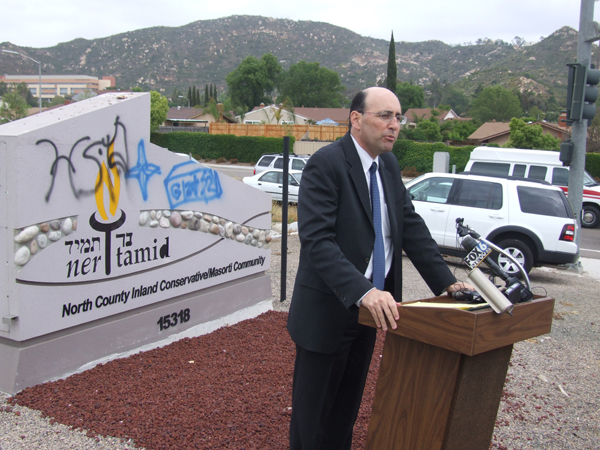
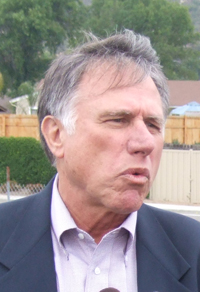 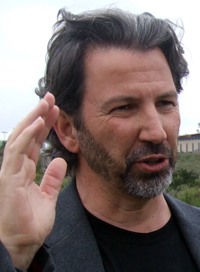 
Freedman noted that the eve of the commemoration of Yom HaShoah was approaching, and said it was sad that so long after the Holocaust,"there are those like the Nazis still around." The congregational president said he believed the unknown perpetrators are a very tiny minority in Poway—a city which he said is praiseworthy in many ways. He said that since the vandalism had become known, there had been an "outpouring of support" for the synagogue from neighoring churches.
The signage along Pomerado Road lies well below the synagogue which sits atop a hill. Freedman said that the vandals apparently did not climb the hill to the sanctuary building.
"We will stand tall and stand confident that the perpetrators will be brought to justice for this heinous act," Freedman said.
Dillon said the ADL is "outraged when any house of worship is vandalized," adding he believed it important for the community to express that outrage lest silence bet taken as approval. By showing its opposition, he said, the community provides the "antidote" for this kind of behavior.
The ADL lay leader noted that other incidents of white supremacist actions have troubled the Poway school system with a swastika smeared from feces on the wall of one school, and a noose placed in the bathroom of another. The Poway Unified School District has been wrestling with what policies are necessary to deter any recurrences.
At Wednesday's news conference, monitored by a representative of the Federal Bureau of Investigation, Sheriff's Detective Hubbert said he was unfamiliar with the other symbols on the street marker of the synagogue at 15318 Pomerado Road.
Rev. Wadge said he leads services at his own church on Sundays, and likes to worship with members of Ner Tamid Synagogue at their services on Saturday mornings. "We need to learn to love one another," he commented. He described the vandalism as an attempt to destroy such good feelings.
 |
Balloon Utopia
Sandi Masori
619 339 8024
 |

! |
 |

'God was in the boxcars'— Lou Dunst
By Vicki Raun
Editor's Note: The following article is reprinted from last month's edition of Tidings, the newsletter of Congregation Beth Israel (CBI)
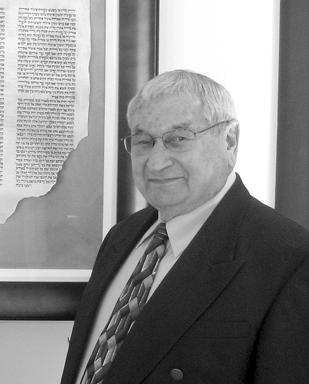  SAN DIEGO —Four times during the Holocaust, CBI member Lou Dunst was loaded into boxcars. Each trip took him into harsher conditions. SAN DIEGO —Four times during the Holocaust, CBI member Lou Dunst was loaded into boxcars. Each trip took him into harsher conditions.
The first trip began in his hometown in the Carpathian Mountains. The entire Jewish community was forced onto a train, including 15-year-old Lou, his parents, brother Irving and sister Risi.
Days later, the doors opened and the Dunst family found itself in a small Hungarian town, soon to be herded into another boxcar. There was no food, water or toilet facilities.
“At the last stop the doors opened up.” Everyone was told to get out in a hurry. “Some were bleeding, some were dying, some were giving birth, some lost their reasoning,” Lou said.
They had arrived at Auschwitz in Poland.
The new arrivals were divided into two groups, one for work and one for death. “That was the last time I saw my mother,” Lou said.
 He found himself in a room of men. “We were told we were going to the gas chamber.” Instead, “we were marched to the railroad and put in boxcars again. “It was very different from before. “There were no women, no children, no elderly, no sick people. They had all been exterminated.” Lou and his brother Irving were seperated from their father at Auschwitz, where he died. He found himself in a room of men. “We were told we were going to the gas chamber.” Instead, “we were marched to the railroad and put in boxcars again. “It was very different from before. “There were no women, no children, no elderly, no sick people. They had all been exterminated.” Lou and his brother Irving were seperated from their father at Auschwitz, where he died.
This time, when the boxcar doors opened, Lou was at Mauthausen. “It was very infamous for torture, sadism.”
At night in the barracks the men lay on their sides on the floor, wedged together with one man’s head sandwiched between two men’s feet.
Lou was among those sent to the gas chamber. The doors were locked. “Of course we were naked completely and jam-packed.” Time passed. “Nothing was happening. After awhile we couldn’t breathe. Some fell on the floor and were trampled on. Suddenly the door opened, and they chased us out.” The men were marched to the center of the camp, where the commandant promised to send them to “a place where we would vanish without cost to the Third Reich.”
Again, a trip by train. This time the boxcar doors opened at Ebensee. “We worked in the stone quarry during the day and built the camp at night with no rest,” Lou recalled.
They were building underground factories in the mountains where German scientists and engineers were building V-2 rockets. “I became a muselmann,” the term for one who could no longer stand or walk. “I had no flesh on my bones.”
The death rate at Ebensee was so high that the crematorium could not keep up. Barely alive, Lou was placed on a pile of dead bodies next to the crematorium.
American soldiers had advanced into the area. Sgt. Bob Presinger drove his tank through the camp fence. Irving pointed to Lou, still alive on the pile of bodies, and said, “That’s my brother. Rescue him.”
The Dunst brothers were later reunited with their sister Risi, who survived Auschwitz.
“God has never forsaken me and I have never forsaken God,” Lou said. “Those people that come up with the question ‘Where is God?’ God was always there. God is with those people who invite God to be with them.”
“I think the Holocaust is something that can not be understood. It’s hard to learn from something we don’t understand.”
To learn more about Lou’s experiences, watch for one of his frequent speaking engagements or take a few moments to read the plaque beneath the Holocaust Torah Scroll portion he donated to CBI, which is in the sanctuary foyer.


Catholic University honors a rabbi for her career pursuing social justice, tikkun olam
By Yvonne Greenberg
 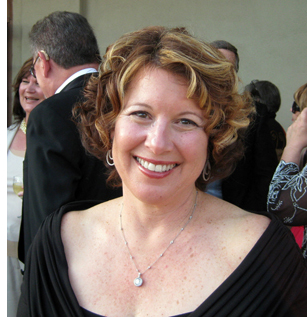 SAN DIEGO—Rabbi Laurie Coskey (pictured at right) , for more than 20 years strongly committed to issues of social justice, received the coveted Author E. Hughes Career Achievement Award from the University of San Diego on April 26. Said USD President Mary E. Lyons: "Rabbi Coskey's history of being an advocate for social justice makes her a perfect selection for this prestigious award. She has created a true legacy of leadership and has touched many lives through her continual contributions in the areas of human and civil rights." SAN DIEGO—Rabbi Laurie Coskey (pictured at right) , for more than 20 years strongly committed to issues of social justice, received the coveted Author E. Hughes Career Achievement Award from the University of San Diego on April 26. Said USD President Mary E. Lyons: "Rabbi Coskey's history of being an advocate for social justice makes her a perfect selection for this prestigious award. She has created a true legacy of leadership and has touched many lives through her continual contributions in the areas of human and civil rights."
Rabbi Coskey earned a doctorate in leadership studies from the University of San Diego's School of Leadership and Education in 2000. She earned her bachelor's degree from Stanford University and was ordained a rabbi in 1985 at Hebrew Union College–Jewish Institute of Religion.
Since 2001 she has led the Interfaith Coalition for Worker Justice (ICWJ), which represents clergy, churches, synagogues, faith, and justice organizations, as well as people of faith, in the San Diego community. She is also co-chair of Clergy and Laity United for Economic Justice–California (CLUE CA) ,is a national spokesperson for the New Sanctuary Movement, and is president of the advisory board to the trustees of the San Diego Community Colleges.
Coskey served Congregation Beth Israel for eight years before completing her doctorate at USD. She is currently spiritual leader of Chavurah Kol Haneshama in San Diego.
She also received the 2008 CAHRO (California Association of Human Rights Organizations) Award, which honored her legacy of leadership as an individual who has made outstanding contributions to California in the area of human and civil rights.
In an interview at USD on April 26 before receiving the award, Rabbi Coskey touched on several issues.
How does it feel to get the award here? "Very exciting. I went back to school many years later after being ordained a rabbi and received my doctorate here in 2000. I have a stepson who is at the University of Washington, named Tyler, and my own two sons, Marshall at UCLA, and my son Aaron, who will soon be a freshman at UC Santa Barbara. They are committed to their studies and giving back to their communities, they are committed to Tikkun Olam, all three of them. I try every day to be a good example. I think that is the best way for us to be as parents. "
What are your plans for future? "At this time, I am executive director of the Interfaith Committee for Worker Justice. We mobilize faith leaders, rabbis, priests, ministers, and imams around issues that affect the poor and the marginalized, particularly around economic justice and better wages and benefits for low wage workers. So my future plans are to continue the work to end poverty in San Diego county, a lofty goal, but it would be a good idea to bring people into the middle class so that they can put braces on their children's teeth and sit at baseball little league games and raise families that are also engaged with their own faith communities, whatever faith it is.
“At one time I was a rabbi at Congregation Beth Israel, but for many years I have been working in the community to improve conditions for working families. This is my full-time work. My work includes engaging politicians to make moral decisions that would be approved of to make a better society. I am also a rabbi at Chavurah Kol Haneshama. And, we meet on the holy days and we are a group of people committed to exploring together the spirituality of the Jewish high holy days.
“One of my greatest goals, God willing, is to become a grandmother. I look forward to travelling with my husband and family and I really look forward to looking back on a career, and commitment, not just to the Jewish community, but to people of faith and the general community in San Diego county over a long period of time."
Was it hard to study for your doctorate at USD and dedicate yourself to social work and be a mother and a wife? "It was hard to study, but in our Jewish tradition we are so accustomed to being people of the book that it was a natural continuation of my rabbinic degree and, interestingly enough, at Stanford as an undergraduate early on, I had studied leadership studies.. And so my doctorate really continues the education I began in the middle ‘70's at Stanford University.
“My advice to children today is that indeed we can have it all but a little at a time, sequentially; that our children and families need us and our jobs need us and we have to not just juggle, but figure out what the priority is at any given time of our life. The only thing I know for sure is that you don't get the time back. We want to raise our families and pursue our own goals. It is wonderful to be part of the community where we are all helping and supporting each other and loving and needing one another."
How do you feel (Rhea Coskey) about your daughter receiving the award tonight? "I am so proud of my daughter. She really makes us proud and the work that she does is really quite astounding. "


#52, KindnessTo make life's wheels go smoothly 'round
There's this that you will find:
You've got to grease the axlerod
With grease of being kind.
Kindness, kindness, I have found,
Makes the world go 'round.
It seems so simple--being kind--
But it's no easy task.
"What's the kind of humankind
That's really kind?" you ask.
Kindness, kindness, I have found,
Makes the world go 'round.
Well, you're the kind that's really kind
When from the very start
Ev'rything you do or say
Is done with kindly heart.
Kindness, kindness, I have found,
Makes the world go 'round.
So, be the kind who's always kind
And you will surely see
Your kind will help all humankind
Improve humanity.
Kindness, kindness, I have found,
Makes the world go 'round.
#78, Ruth's Song
Wherever you go I will always go with you
Your land and people are my land and people, too.
Naomi, how I miss your son,
My husband, in the grave!
Where's the fam'ly warmth I need,
The kinship that I crave?
Wherever you go I will always go with you
Your land and people are my land and people, too.
Not here in Moab's bitter land
That drowns in tears I shed.
My homeland is no home for me
Now my husband's dead.
Wherever you go I will always go with you
Your land and people are my land and people, too.
So, as you leave for Bethlehem,
Returning to your land,
I will share your people's fate. . .
Naomi, take my hand!
Wherever you go I will always go with you
Your land and people are my land and people, too.
(
# 118, Bar Mitzvah
Today's the day that he's a man:
That's what the day's about.
But even though some say it's true,
I really have my doubt,
For manhood's not a sudden storm
Bursting from the sky.
It rather comes in tiny drops,
Or sometimes passes by.
Today's the day that he's a man:
That's what the sages say.
And yet my eyes can clearly see
It's really not that way.
For manhood's not a common weed
Sprouting overnight;
It rather needs, as redwoods do,
Time for growing right.
Manhood comes in special ways:
It grows in tiny spurts.
It shows in love and tenderness
That help to heal life's hurts.
It blooms in those who selflessly
Give themselves to giving.
A worthy boy becomes a man
Through years of selfless living.
A worthy boy becomes a man
Through years of selfless living.

ADVENTURES IN SAN DIEGO JEWISH HISTORY
Editor's Note: We are reprinting news articles that the Southwestern Jewish Press ran in 1950. If you have historical topics about the San Diego Jewish community you would like us to explore, please e-mail your suggestions to editor Don Harrison at sdheritage@cox.net
San Diego Bay City Bnai Brith
From Southwestern Jewish Press, January 13, 1950, page 6
The newly organized chapter of the San Diego Bay City B’nai B’rith women will hold its first institution and installation of officers on Sunday, January 29th in the Don Room of the El Cortez Hotel. Dinner will be served at 6 p.m. and the institution and installation of officers immediately following the dinner will be conducted by an officer of the Grand Lodge.
Those to be installed are as follows: Mrs. Harold Garvin, President; Mrs. David Schloss, 1st Vice Pres.; Mrs. Sidney Rose, 2nd Vice Pres.; Mrs. Stanley Youkon, Recording Secretary; Mrs. Victor Weiss, Corresponding Sec.; Miss Sadie Rothenberger, Financial Sec.; Mrs. Rose Sloane, Treasurer; Mrs. Tom Turner, Guardian; Mrs. Charles Deuitch, Sentinal; MR. Rose Abrahams; Ms. Eva Berger and Mrs. E. Max Cohen as trustees.
In the month of November, our ladies made it possible for a carton of soap to be sent through “Care,” to needy children in Europe. It is one of B’nai B’rith women’s pleasures to take part and give loyal support to all worthy causes.
Our membership Chairman, Mrs. Sidney Rose, at T-7586, will extend a cordial welcome to all ladies who are interested in joining our activities.
The pre-installation dinner is open to all who wish to participate at the complete price of $2.75. The David Barker Quintet will provide dinner music. Dinner reservations are being taken by Mrs. David Schloss at J-2825 and Mrs. Victor Weiss at T.1-4571.
Jewish Chaplain Is Assigned to San Diego
From Southwestern Jewish Press, January 27, 1950, page 1
The first Jewish Chaplain to be attached to the Naval Training Center reported for duty this past week. He is Chaplain Garson Goodman.
Chaplain Goodman, who is a native of Cleveland, is in his first tour of Naval duty. Entering the Navy in May of 1949, he attended the first class of newly organized Chaplains’ School at Washington, D.C.
Upon completion of the nine months’ school, he then came to the Naval training Center. Of that first class, two of his classmates, a Protestant and a Catholic Chaplain, have been assigned to nearby Camp Pendleton at Oceanside.
Before coming into the Naval service, the Chaplain had a congregation at Harlan, Kentucky for two years. He is residing with his wife in Mission Hills.
Christian-Palestine Committee to be Formed in San Diego
From Southwestern Jewish Press, January 27, 1950, page 1
On January 23rd a Seminar sponsored y the American Christian Palestine Committee was held at the Miramar Hotel in Santa Monica.
San Diegans attending were: Dr. Kenneth E. Barnhart, Professor, San Diego State College; Judge A.S. Molina, Municipal Court No. 4; Mrs. A.J. Sutherland, President, Security Trust & Savings Bank; Lenore Panunzio, Mary Fay, member of the Board of Education; Mrs. Marney Mintzer, Past President, Mentaly Hygiene Assn.
Among the speakers at the Seminar were: Manchester Boddy, publisher, Los Angeles Daily News; Dr. Carl Herman Voss, Chairman, and Rev. Karl Baehr, Executive Secretary of the Executive Council of American Christian Palestine Committee; Alica Klausner Eskol, a Sabra from Jerusalem, and Rabbi Max Nussbaum. Edgar Ansel Mowrer was Commentator.
Others attending from San Diego were Muriel Goldhammer, Acting Chairman of the San Diego Zionist Council, and Sam Slayen, President of Paole Zion.
The American Christian Palestine Committee is composed of non-Jews who are interested in the New Stat of Israel and work to disseminate information regarding its activities.
The delegates decided, after sitting through the interesting panels that they would like to form a San Diego Christian-Palestine Committee. Plans for this are now under way.

SAN DIEGO JEWISH WORLD THE WEEK IN REVIEW
Shoshana Bryen in Washington, D.C.: Could Mohammed ElBaredei have a bias?
Carol Davis in San Diego: Gaviota: hacienda tale in Porfirio's time
Garry Fabian in Melbourne, Australia:
—Search for missing Israeli back packer
—University appointment cause of conflict
—Extradition moves closer for Zentai
—Remembering Jewish Anzacs
—Marchers set to depart for Poland
—Interfaith professorship for Rabbi John Levi
—Bridge-building an ongoing project
Donald H. Harrison in San Diego: Filner turns spotlight on veterans' suicides
Adventures in San Diego Jewish History: What was the Jewish community news in 1949? Archives of the Southwestern Jewish Press provide some of it.
Donald H. Harrison in San Diego: 'Dreamcoat': A cup for Judaism's candle
Rabbi Dow Marmur in Jerusalem: Shas leaders: so 'religious,' yet so corrupt
Lynne Thrope in San Diego: Liz Bartell ambiance, Paul Murphy cuisine are perfect mother's reward at Humphrey's
Adventures in San Diego Jewish History: What was the Jewish community news in 1949? Archives of the Southwestern Jewish Press provide some of it.
Donald H. Harrison in La Mesa, California: La Mesa developer saw 'Promised Land' from the heights of his own Mount Nebo
Rabbi Dow Marmur in Jerusalem: How Israel at 60 differs from Israel at 50
Sheila Orysiek in San Diego: Klezmer—Jewish music for your soul
Ira Sharkansky in Jerusalem: Palestinian choice: delusions or own state
Adventures in San Diego Jewish History: What was the Jewish community news in 1949? Archives of the Southwestern Jewish Press provide some of it.
Judy Lash Balint in Jerusalem: A Jerusalem sight not to be passed over
Shoshana Bryen in Washington, D.C.: Why is Olmert discussing Golan Heights?
Rabbi Baruch Lederman in San Diego: Chofetz Chaim Yeshiva leader Rabbi Henoch Leibowitz, ztzl, had spiritual magnetism
Rabbi Dow Marmur in Jerusalem: Is Kadish kaddish for Pollard's freedom?
Rabbi Leonard Rosenthal in San Diego: Minyan prayer for 3 kidnaped soldiers
Ira Sharkansky in Jerusalem: Political smoke in the Israeli winds
Adventures in San Diego Jewish History: The Southwestern Jewish Press in July 1949 printed articles detailing the histories and purposes of various Jewish organizations in San Diego. We reprint some of them here.
Shoshana Bryen in Washington D.C.: Syrian-Korean nuclear program mysteries
Gerry Greber in Carlsbad, California: Is afikomen needed if end-product near?
Rabbi Dow Marmur in Jerusalem: Syrian-Israeli peace: genuine offer from President Assad or just a cynical ploy?
Sheila Orysiek in San Diego: Chapter Five in the serialization of her novel, Reluctant Martyr
Adventures in San Diego History: The Southwestern Jewish Press in July 1949 printed articles detailing the histories and purposes of various Jewish organizations in San Diego. We reprint some of them here.
< BACK TO TOP
|
|
